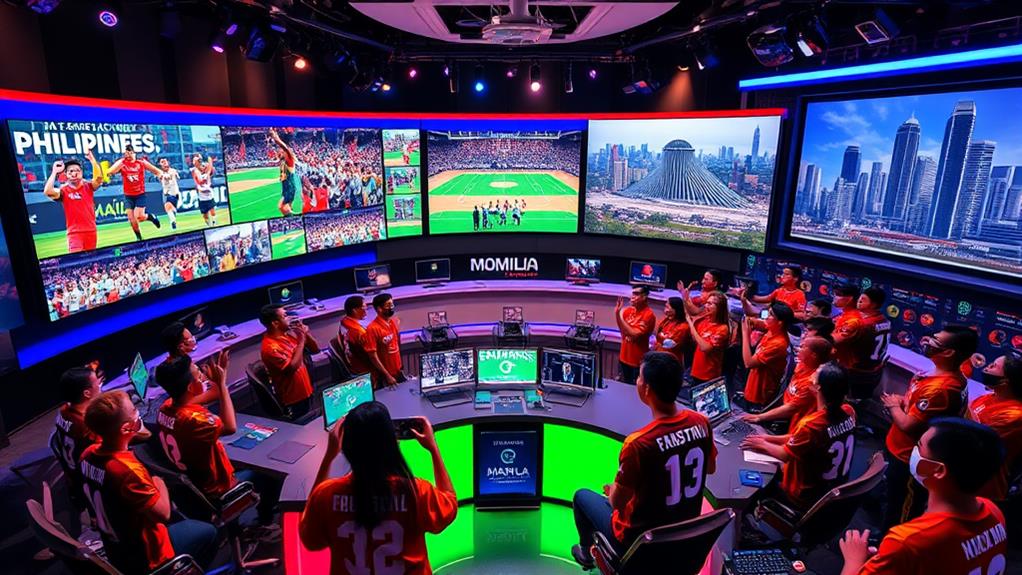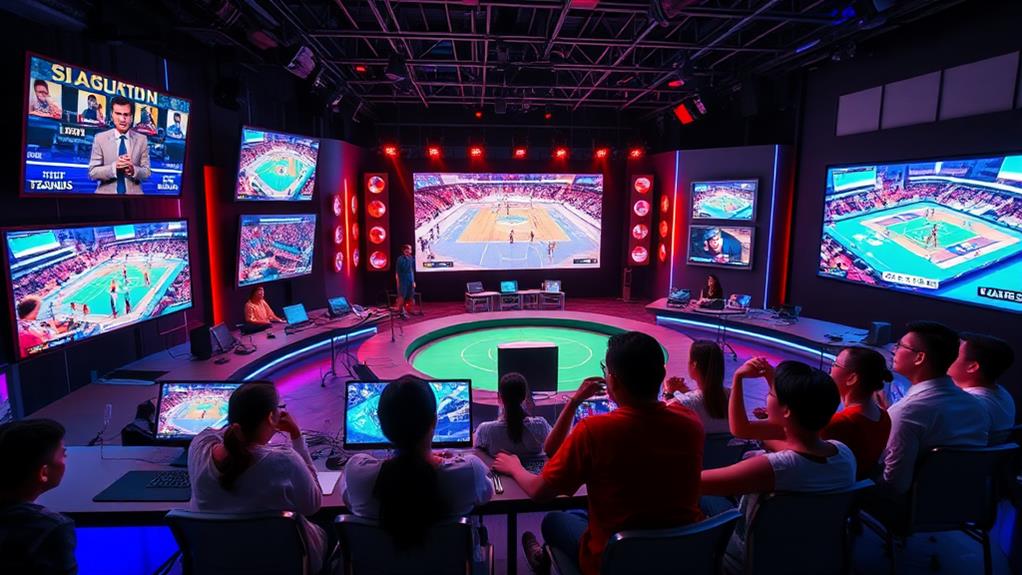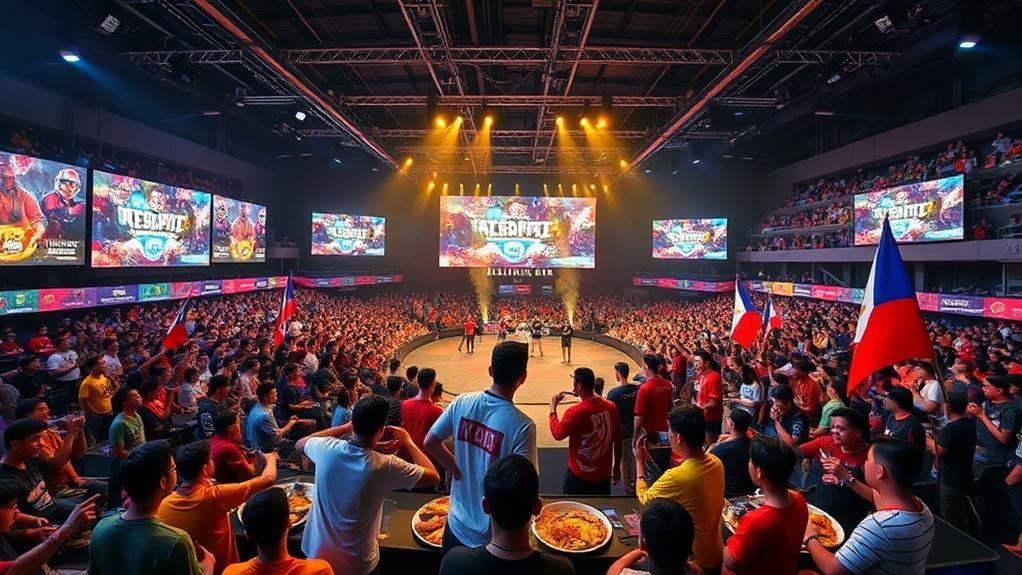The sports broadcasting market in the Philippines is growing rapidly, with a projected value of $8.2 billion. This growth is driven in part by the popularity of basketball, with 75% of fans eager for more basketball content.
The shift to Over-the-Top (OTT) platforms is transforming the way people consume sports in the Philippines. OTT platforms provide interactive and customizable viewing experiences, which are essential for engaging the country's predominantly mobile audience.
In contrast, traditional cable TV is losing ground as viewers increasingly turn to streaming services for their sports fix.
Innovations in technology, such as virtual and augmented reality, will further enhance viewer participation and satisfaction. Moreover, the rising interest in esports is expected to drive growth in the sports broadcasting market.
As a result, the future of sports broadcasting in the Philippines will be shaped by new opportunities and strategies that will redefine how people enjoy sports in the country.
Market Overview and Trends

The Philippine sports broadcasting landscape is evolving rapidly, driven by significant market trends and demographic shifts.
The Philippine telecom and pay-TV market was valued at $8.2 billion in 2022, with a projected compound annual growth rate (CAGR) of over 2% through 2027. This growth is largely fueled by advancements in mobile data and fixed broadband services.
Major players like MediaQuest Holdings Inc., BeIN Sports, and Cignal are key to this transformation. BeIN Sports has secured rights for prestigious leagues such as LaLiga and Serie A.
However, traditional cable television is facing challenges as younger audiences increasingly gravitate towards on-demand content. The entry of DITO Telecommunity in 2021 has intensified competition, pushing Globe Telecom and PLDT to innovate further.
Over 75% of the population identifies as basketball fans, providing a substantial opportunity for sports media to cater to local interests.
The push towards streaming services is reshaping how sports content is consumed, making personalized viewing experiences more accessible than ever before.
Rise of OTT Platforms
The Philippine sports broadcasting landscape is shifting towards OTT platforms, which are gaining popularity as the preferred choice for viewers seeking on-demand content. This shift is driven by the availability of high-speed internet and smart devices, allowing viewers to watch sports content at their convenience, regardless of time or location.
The telecom and pay-TV market in the Philippines was valued at $8.2 billion in 2022, indicating a significant market for OTT platforms to tap into. SetantaSports.com is emerging as a key player, offering tailored viewing experiences and extensive coverage of major sports leagues that resonate with Filipino sports fans.
Globally, there's a trend towards cord-cutting, with an estimated 47.6 million US households abandoning traditional cable TV in favor of streaming services. This shift is particularly significant among younger demographics, where sports and esports are gaining popularity.
OTT platforms are enhancing fan engagement by encouraging interaction and building a vibrant community around shared passions. This interaction not only keeps fans connected to their favorite teams but also fosters a sense of community among viewers.
The rise of OTT platforms signals a dynamic change in how sports will be experienced in the Philippines, offering a more personalized and engaging experience for viewers.
Key Broadcasters in the Philippines

Key Players in Philippine Sports Broadcasting
In the Philippines, several major sports broadcasters are revolutionizing the way fans engage with their favorite sports.
Leading Pay-TV Sports Content Provider
Cignal, a subsidiary of MediaQuest Holdings Inc., dominates the pay-TV sports content market, catering to a growing audience.
Elite Leagues and Events
BeIN Sports, launched in 2013, has secured exclusive rights to elite leagues like LaLiga and Formula 1, enriching viewers' experiences.
Mobile Sector Dominance
Globe Telecom and PLDT dominate the mobile sector, leveraging their platforms to influence sports broadcasting.
Adapting to Changing Consumer Demands
As consumers increasingly seek diverse viewing options, these broadcasters are adapting to meet expectations.
The competition intensified with DITO Telecommunity's entry, pushing all players to innovate.
Dynamic Sports Media Landscape
With the rise of cable TV and digital platforms, a more dynamic sports media landscape is emerging, keeping fans engaged.
The ongoing evolution of these key broadcasters ensures that exciting live events remain accessible, transforming how fans experience sports in the Philippines.
Impact of COVID-19
The COVID-19 pandemic has significantly reshaped the sports media landscape in the Philippines. Traditional broadcasting faced disruptions from restrictions on live events, accelerating the shift toward digital and streaming platforms.
Key changes in the industry include:
- Increased demand for online sports content, leading to a surge in online sports content offerings.
- Enhanced digital offerings, with networks innovating with new technology to meet the growing demand.
- Real-time monitoring, enabling quick adaptation to viewer needs and preferences.
- Remote workflows, which became essential for maintaining audience engagement during lockdowns.
- Cloud-based production, allowing for the continued delivery of content despite physical restrictions.
Market data reveals a significant shift in consumer behavior, with many fans embracing live streaming services.
The pandemic has underscored the need for agile and innovative solutions in sports broadcasting, making technologies that enable remote workflows crucial for maintaining audience interest.
The crisis has highlighted the importance of technology in broadcasting and set the stage for future growth.
To thrive in a post-pandemic world, broadcasters must prioritize digital strategies that cater to the evolving needs and preferences of sports fans.
How Will Social Media Affect the Future of Sports Broadcasting in the Philippines?
The impact of social media sports on the future of sports broadcasting in the Philippines is significant. Social media platforms provide a direct avenue for sports organizations to reach and engage with fans. It also allows for real-time updates and interactive content, ultimately shaping the way sports are consumed and experienced.
Growing Interest in Esports

Esports in the Philippines: A Rapidly Growing Industry
The Philippines has emerged as a significant player in the global esports industry, with a market growth rate of 12.9% year-over-year since 2017. This rapid expansion is driven by the country's large gaming population, with over 43 million active gamers.
International Recognition and Government Support
Major esports tournaments in the Philippines are gaining international attention, providing a platform for local teams to compete on the global stage. The government's support for sports initiatives has created a nurturing environment for the industry to flourish.
Mobile Gaming Market and Youth Enthusiasm
The mobile gaming market in the Philippines is projected to reach $1.5 billion by 2025, driven by the enthusiasm of the country's youth for esports. This growing demand is expected to contribute significantly to the industry's continued growth.
A Bright Future in Sports Broadcasting and Engagement
As the popularity of esports continues to rise, the Philippines is positioning itself as a significant player in the international esports arena. This trend is expected to pave the way for a bright future in sports broadcasting and engagement, with esports at the forefront of the transformation in the way people watch sports.
Future Strategies for Engagement
Captivating Sports Fans in the Philippines with Innovative Strategies
The future of sports engagement in the Philippines relies on embracing emerging trends and technologies. Offering free ad-supported streaming television (FAST) is crucial, as it allows sports fans to access content without subscription fees. This is particularly important, given that over 50% of the TV audience in the Philippines prefers mobile viewing, making mobile-friendly content delivery essential for enhancing viewer engagement.
Customized experiences are key to keeping fans engaged. For instance, SetantaSports.com's multiview function allows fans to watch multiple events simultaneously, catering to their demand for tailored sports consumption.
Integrating technology, such as remote production workflows and enhanced metadata, creates more interactive viewing experiences that resonate with modern audiences.
To stay competitive in the sports broadcasting landscape, collaborations between local and international media companies are vital. These partnerships can foster innovative content delivery methods, ensuring relevance and leadership in sports engagement.
Questions and Answers
How Will Sports Media Change in the Future?
Sports media will undergo a significant transformation in the future. This change will be driven by the integration of digital streaming and virtual reality, which will create immersive experiences for fans.
For instance, virtual reality will allow fans to feel as if they're on the field, enhancing their engagement with the game.
Personalized content will become the norm. Data analytics will play a key role in tailoring content to individual preferences, making the viewing experience more personal.
For example, sports platforms will use data to recommend specific games, highlight reels, or analysis based on a fan's viewing history and interests.
Real-time interactivity will revolutionize the viewing experience. As platforms innovate, fans will be able to engage with the action in real-time, whether through live chats, polls, or interactive graphics.
This interactivity will keep fans connected to the action and create a more dynamic experience.
The overall sports experience will be redefined. This shift towards a more engaging and customized approach will change how fans consume sports.
The result will be a more immersive, personal, and interactive experience that enhances overall enjoyment.
What Is the Future of Sports Watching?
The future of sports watching is shifting towards a more immersive and interactive experience.
This change is driven by the rise of streaming platforms, which allow for live chats and social media interactions that enhance fan engagement.
With mobile accessibility, fans can now catch every game on-the-go, ensuring they never miss a moment of their favorite sports.
Virtual reality technology is also being integrated into the viewing experience, providing an immersive and lifelike feel that puts fans right in the action.
This transformation not only elevates the viewing experience but also alters how fans connect with their favorite sports and teams.
What Is the Future of TV Broadcasting?
The future of TV broadcasting is undergoing a significant transformation. This change is driven by the rise of streaming innovations and the need for increased audience engagement.
Traditional TV viewing is declining. As a result, broadcasters must adapt to new trends to remain relevant. One key shift is towards mobile accessibility, making it easier for viewers to watch their favorite shows anywhere, at any time.
For example, many TV networks now offer mobile apps that allow users to stream live TV or catch up on missed episodes.
Virtual reality (VR) is set to revolutionize the viewing experience. VR technology will immerse viewers in a more interactive environment, allowing them to engage with content in new and innovative ways.
For instance, sports fans could use VR to feel like they're sitting in the stadium, while drama fans could explore virtual sets and interact with characters.
To stay ahead, broadcasters must meet evolving viewer preferences and habits. This means embracing digital technologies and providing a more personalized viewing experience.
What Is the Growth Rate of Sports Broadcasting?
The growth rate of sports broadcasting is driven by digital platforms and streaming services.
This trend is fueled by the shift of audiences from traditional TV, which attracts advertisers seeking to tap into this new market.
As a result, advertising revenue is increasing.
With sports content becoming more accessible through various streaming options, audience engagement is enhanced.
This shift not only caters to changing viewer preferences but also creates new opportunities for broadcasters to innovate and expand their offerings in an evolving market.